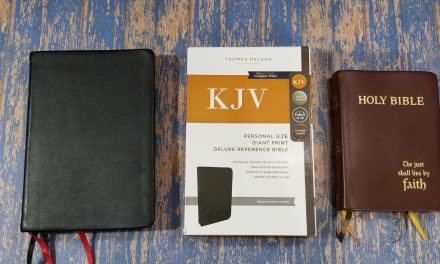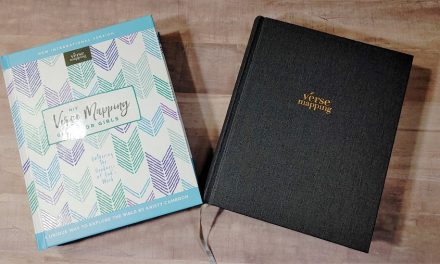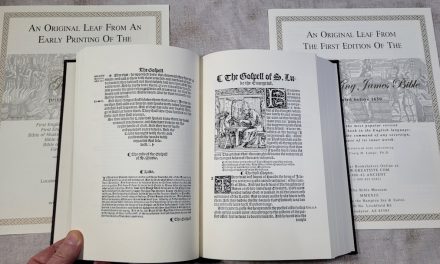The large or giant print KJV with center column references is a standard in Bible publishing. Practically every KJV publisher has one including Zondervan. In this Bible review I take a look at Zondervan’s low-priced Giant Print Reference Bible (ISBN 9780310931720) in burgundy bonded leather. The suggested retail price is $17.99. It can often be found for much less. Even though it’s a low-priced Bible it has a lot to offer.
______________________________
______________________________
Binding
The cover is burgundy bonded leather with a paper liner and a glued binding. This is not the kind of cover that would last with lots of use but this Bible is cheap enough that it does make it a good choice to carry and use when you need to take a Bible without worrying what happens to it. The cover will stay open in Genesis 1 but it might need to be broken in first. It does not include a ribbon.
The overall size is 9.5 x 6.5 x 1.25”.
Paper
The paper feels like it’s in the low 30’s for gsm. It has a smooth texture and an eggshell white color. The smooth texture can sometimes make it a little difficult to turn pages. It’s highly opaque but it does have a slight glare under direct light, but the text remains readable.
The gold gilt looks sprayed on. It has a few small gold paint splotches on some of the pages.
Typography
This is a two-column verse-by-verse format with center column references. The header includes the book name, and chapter and verse numbers in the outer margin, page number in the center, and page summaries in the inner margin. Books start on a new page, giving room for notes.
The font is 11.6 point in red letter. It’s semi-bold and the print quality is easily on par with the best available. The red text is a touch darker and bolder than many red-letter editions. The black and red both are consistent throughout.
It isn’t self-pronouncing. This makes readability smoother. It does have italics for supplied words (which I prefer). References are keyed with letters while footnotes are keyed with numbers. The letters for references are small and are easy to ignore. The numbers for footnotes are large.
It has around 30 characters per line, giving space for around 5 or six words per line on average. It has 48 lines per page. The text never seems scrunched.
Each verse is indented. On one hand that makes them easier to find, but on the other hand they stand apart as if they were meant to be separated from the surrounding text. This can be awkward when a single sentence takes several verses, for example Eph. 3:1-7.
References and Footnotes
There are over 45,000 cross references and the translator’s footnotes in the center columns. The references and footnotes for the left column are placed at the top, while those for the right column are placed at the bottom of the column. This leaves lots of room in the center of the column for most pages that can be used for references or small notes.
I’m glad to see the footnotes are included. In my opinion the translator’s footnotes are part of the translation (for all translations) help shed light of the translator’s thoughts about words and phrases in the Greek and Hebrew. They also show alternate renderings, alternate spellings of names, etc. It’s good to see them included, especially when the modern trend in publishing is doing away with them.
The references ad footnotes are printed in a larger font than most Bibles. They take more space but they’re also easy to read.
A side note – these are the references and footnotes used by Cambridge for their KJV Clarion (one of my most recommended Bibles).
Here are a few examples of references to help you compare:
- Genesis 1:1 – Jn. 1:1, 2; Heb 1:10; Ps 8:3; Is 44:24; Ac 17:24; Rev 4:11
- Deuteronomy 6:4 – Jn 17:3; 1 Cor 8:4, 6
- Isaiah 9:6 – ch 7:14; Lk 2:11; Jn 3:16; Mat 28:18; 1 Cor 15:25; Judg 13:18; Titus 2:13; Eph 2:14
- Matthew 17:20 – ch 21:21; Mk 11:23; Lk 17:6; 1 Cor 12:9; 13:2
- Mark 11:23 – Mat 17:20; 21:21; Lk 17:6
- Mark 12:29 – Dt 6:4; Lk 10:27
- John 1:1 – Pr 8:22; 1 Jn 1:1; Pr 8:30; ch 17:5; 1 Jn 5:7
- Acts 2:38 – Lk 24:47; ch 3:19
- 1 John 1:1 – Jn 1:1; 14; 2 Pet 1:16; Lk 24:39; Jn 20:27
Bible Study Helps
There are a few articles and charts in the back that are helpful for study. They include:
- About the Bible
- Overview of the Bible
- Captivity and Return
- Between the Testaments
- Prayers of the Bible
- Prophecies Fulfilled in Christ
- The Parables of Jesus
- The Miracles of Jesus
- The Ministry of Jesus
- Teachings of Jesus
- Where to Find it on the Bible
- The ABC’s of Salvation
The front includes an article called How to Study the Bible and several reading plans.
Reading Plans include three tracks: introduction to the Bible, every book of the Bible, every word of the Bible. Each reading has a check box so you can mark when you’ve completed a reading.
Concordance
The concordance is 48 pages with 2 columns per page. Some of the entries include multiple forms of a word. When this is the case the other forms are placed in parenthesis. There’s enough here for some basic study. Here’s a sampling of entries with the number of references for each:
- Christ – 17
- Christian (Christians) – 2
- Faith – 5
- Faithless – 1
- Faithful – 15
- Faithfulness – 4
- God – 12
- Godhead – 2
- Godly – 2
- Godliness – 4
- Praise (Praised) – 9
- Praises (Praising) – 3
- Pray – 13
- Praying (Prayed) – 3
- Prayer – 12
- Prayers – 2
Maps
The box shows 8 pages of maps but it actually has 16 pages of maps printed on thick semi-glossy paper. There isn’t an index to maps but the maps are annotated so things are easy to find.
Here is the list of maps:
- World of the Patriarchs
- Holy Land and Sinai
- Exodus and Conquest of Canaan
- Land of the Twelve Tribes
- Kingdom of David and Solomon
- Kingdoms of Israel and Judah
- Prophets in Israel and Judah
- Assyrian and Babylonian Empires
- Holy Land in the Time of Jesus
- Jerusalem in the Time of Jesus
- Jesus’ Ministry
- Apostles’ Early Travels
- Paul’s Missionary Journeys
- Roman Empire
Conclusion
Zondervan’s Giant Print Reference Bible has a lot of tools and excellent print quality at such a low price. This is a great choice for a beginner’s Bible or a Bible that you want to carry around and not worry what happens to it. The glued binding and bonded leather won’t last for years, but at this price-point it still has its uses and is a great alternative to the more expensive editions. The bold text makes it good for preaching and the tools are good for basic study.
I recommend Zondervan’s Giant Print Reference Bible for anyone looking for a bold print Bible with good tools for basic study at an affordable price.
______________________________
______________________________
Photography by hannahCbrown
Zondervan provided this Bible free for review. I was not required to give a positive review – only an honest review. My opinions are my own.































It would be nice if Zondervan would first make this available in a 9-10pt for the overwhelming majority of people with normal vision – and in genuine leather. This giant print has letters so big that I feel like I’m reading so slow. I don’t like it.
Good point Stan.
I purchased a Large Print KJV Thinline Filament Enabled Bible because I liked the idea of the Filament app, and I needed a larger print because my eyes are getting worse than they were, but the 10 point font is a little hard to read combined with the thinness of the paper and how crowded together the verses are. I can read it, but it takes a lot of focusing.
I considered their giant print personal size, which has a 12 point font, but am concerned about the paper maybe being the same thinness.
Then, I found this Bible, the Zondervan giant print, at Ollie’s last night and it was only $9.99, so I bought it. I LOVE the font, the size of the print, and how bold it is!!! And, the paper seems to show through a little less, and has more clean space around the verses. But, to my dismay, I’ve realized that the binding is glued, and I want a Bible that I can get into, get to know, and possibly later get rebound in a great leather (I’m more of a one Bible and memorize it kind of person). You’ve seen them all, pretty much!!! Is there another non-premium KJV Bible that has a sewn binding that you can think of that has a similar font, print size, and boldness of print combined with a thick enough paper so the print on the other side doesn’t interfere with reading? I’m a diabetic and my eyes are just getting worse. Help! And thanks!
Hi Candi. There aren’t a lot of options with a dark font, opaque paper, and a sewn binding, but the Confort Print from Thomas Nelson might be what you’re looking for. Here are a few of my favorites:
Preaching Bible (some of the best paper) – https://biblebuyingguide.com/thomas-nelson-kjv-preaching-bible-review/
Lower cost Giant Print Reference (same as the Premier Collection but with lower quality materials) https://biblebuyingguide.com/thomas-nelson-giant-print-kjv-reference-bible-review/
Text only – https://biblebuyingguide.com/kjv-giant-print-thinline-bible/
Delighted that i came across this article i have been looking for this exact bible please direct me to a store with this exact one. You can email me bernie.dyani@gmail.com